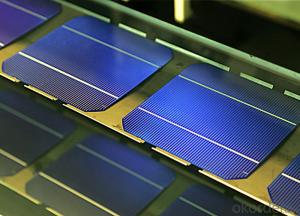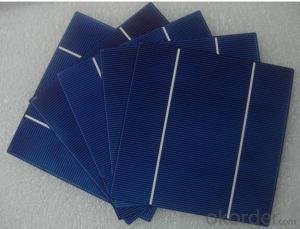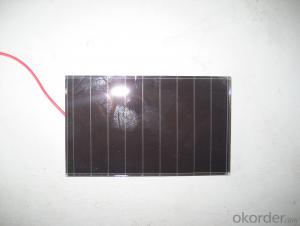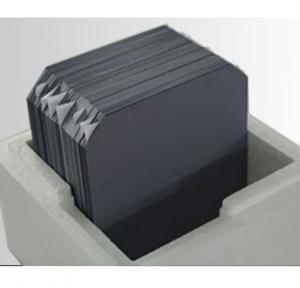Solar Cell High Quality A Grade Cell Polyrystalline 5v 17.8%
- Loading Port:
- Shanghai
- Payment Terms:
- TT OR LC
- Min Order Qty:
- 1000 pc
- Supply Capability:
- 100000 pc/month
OKorder Service Pledge
OKorder Financial Service
You Might Also Like
Specifications
hot sale solar cell
1.16.8%~18.25% high efficiency
2.100% checked quality
3.ISO9001/ISO14001/TUV/CE/UL
4.stable performance
We can offer you the best quality products and services, don't miss !
POLY6'(156*156)
Polycrystalline Silicon Solar cell
Physical Characteristics
Dimension: 156mm×156mm±0.5mm
Diagonal: 220mm±0.5mm
Thickness(Si): 200±20 μm
Front(-) Back(+)
Blue anti-reflecting coating (silicon nitride); Aluminum back surface field;
1.5mm wide bus bars; 2.0mm wide soldering pads;
Distance between bus bars: 51mm . Distance between bus bars :51mm .
Electrical Characteristics
Efficiency(%) | 18.00 | 17.80 | 17.60 | 17.40 | 17.20 | 16.80 | 16.60 | 16.40 | 16.20 | 16.00 | 15.80 | 15.60 |
Pmpp(W) | 4.33 | 4.29 | 4.24 | 4.19 | 4.14 | 4.09 | 4.04 | 3.99 | 3.94 | 3.90 | 3.86 | 3.82 |
Umpp(V) | 0.530 | 0.527 | 0.524 | 0.521 | 0.518 | 0.516 | 0.514 | 0.511 | 0.509 | 0.506 | 0.503 | 0.501 |
Impp(A) | 8.159 | 8.126 | 8.081 | 8.035 | 7.990 | 7.938 | 7.876 | 7.813 | 7.754 | 7.698 | 7.642 | 7.586 |
Uoc(V) | 0.633 | 0.631 | 0.628 | 0.625 | 0.623 | 0.620 | 0.618 | 0.617 | 0.615 | 0.613 | 0.611 | 0.609 |
Isc(A) | 8.709 | 8.677 | 8.629 | 8.578 | 8.531 | 8.478 | 8.419 | 8.356 | 8.289 | 8.220 | 8.151 | 8.083 |
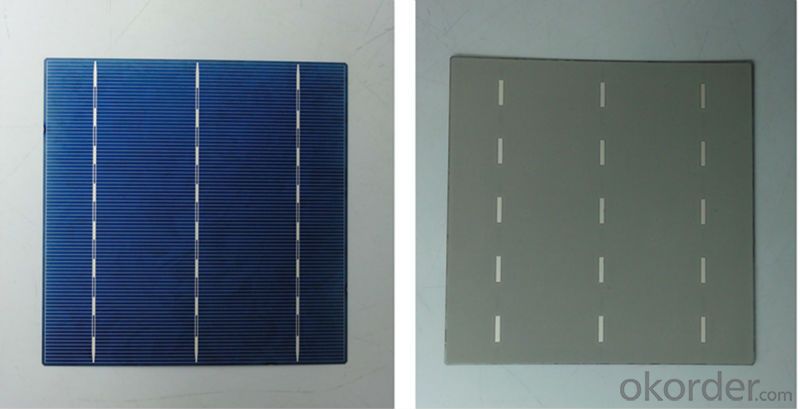
MONO5'(125*125mm)165
Monocrystalline silicon solar cell
Physical Characteristics
Dimension: 125mm×125mm±0.5mm
Diagonal: 165mm±0.5mm
Thickness(Si): 200±20 μm
Front(-) Back(+)
Blue anti-reflecting coating(silicon nitride); Aluminum back surface field;
1.6mmwide bus bars; 2.5mm wide soldering pads;
Distance between bus bars: 61mm . Distance between bus bars :61mm .
Electrical Characteristics
Efficiency(%) | 19.40 | 19.20 | 19.00 | 18.80 | 18.60 | 18.40 | 18.20 | 18.00 | 17.80 | 17.60 | 17.40 | 17.20 |
Pmpp(W) | 2.97 | 2.94 | 2.91 | 2.88 | 2.85 | 2.82 | 2.79 | 2.76 | 2.73 | 2.70 | 2.67 | 2.62 |
Umpp(V) | 0.537 | 0.535 | 0.533 | 0.531 | 0.527 | 0.524 | 0.521 | 0.518 | 0.516 | 0.515 | 0.513 | 0.509 |
Impp(A) | 5.531 | 5.495 | 5.460 | 5.424 | 5.408 | 5.382 | 5.355 | 5.328 | 5.291 | 5.243 | 5.195 | 4.147 |
Uoc(V) | 0.637 | 0.637 | 0.636 | 0.635 | 0.633 | 0.630 | 0.629 | 0.629 | 0.628 | 0.626 | 0.626 | 0.625 |
Isc(A) | 5.888 | 5.876 | 5.862 | 5.848 | 5.839 | 5.826 | 5.809 | 5.791 | 5.779 | 5.756 | 5.293 | 5.144 |

FAQ:
Q:How can i get some sample?
A:Yes , if you want order ,sample is not a problem.
Q:How about your solar panel efficency?
A: Our product efficency around 17.25%~18.25%.
Q:What’s the certificate you have got?
A: we have overall product certificate of ISO9001/ISO14001/CE/TUV/UL
- Q:Can solar silicon wafers be used in portable solar panels?
- Yes, solar silicon wafers can be used in portable solar panels. The silicon wafers are the key component in solar panels that convert sunlight into electricity, and they can be used in portable panels to harness solar energy for various applications such as charging electronic devices or powering small appliances on the go.
- Q:What is the role of back surface field (BSF) on solar silicon wafers?
- The role of the back surface field (BSF) on solar silicon wafers is to reduce the recombination of charge carriers at the rear surface of the wafer. This is achieved by creating a high concentration of dopant atoms at the back surface, which forms a gradient that helps to separate the photo-generated carriers from the rear surface. The BSF also increases the efficiency of the solar cell by improving the collection of charge carriers and reducing the energy losses due to recombination.
- Q:Can solar silicon wafers be used in solar-powered electric vehicles?
- Yes, solar silicon wafers can be used in solar-powered electric vehicles. These wafers are typically used in photovoltaic (PV) solar panels to convert sunlight into electricity. By integrating solar panels made of silicon wafers onto the surface of a solar-powered electric vehicle, it can generate electricity from the sun and contribute to powering the vehicle. However, the efficiency and power output of the solar panels depend on various factors such as the size of the panels, the quality of the silicon wafers, and the amount of sunlight available.
- Q:From raw materials to finished products processing and production of the main links? Construction technology? Key issues of safety in production? What security measures are generally taken?
- (4): end shoulder growth after a long thin neck, to reduce the temperature and casting speed, the crystal diameter gradually increased to the desired size. (5) the diameter growth: after a long neck and shoulder end, by continuously adjusting casting speed and temperature, the crystal diameter maintained at between 2mm positive and negative, the diameter of fixed part is called the diameter part. Monocrystalline silicon wafer from the equal diameter part. (6) tail growth: if the rod is separated from the liquid surface, the effect force will cause the dislocation and slip line of the crystal rod. So in order to avoid the occurrence of this problem, the diameter of the crystal rod must be gradually reduced until it is a sharp point and separated from the liquid surface. This process is called tail growth. After a long period of time, the crystal rod is taken out of the furnace chamber for cooling for a period of time to complete a growth cycle.
- Q:How does the efficiency of a solar silicon wafer change with humidity?
- The efficiency of a solar silicon wafer generally decreases with increasing humidity. High humidity levels can cause moisture to accumulate on the surface of the wafer, leading to a decrease in the wafer's ability to convert sunlight into electricity. This moisture can create a barrier that reduces the amount of light reaching the semiconductor material, thereby reducing the overall efficiency of the solar cell. Furthermore, humidity can also affect the electrical properties of the silicon material, leading to increased resistance and decreased performance. Therefore, it is important to consider humidity levels when evaluating the efficiency of a solar silicon wafer.
- Q:What is the impact of surface recombination on the performance of solar silicon wafers?
- Surface recombination refers to the loss of charge carriers at the surface of a solar silicon wafer, which significantly affects its performance. High surface recombination rates can lead to reduced efficiency in converting sunlight into electricity. This is because surface recombination acts as a pathway for the recombination of photo-generated charge carriers, thus decreasing the number of carriers that can contribute to current generation. Therefore, minimizing surface recombination is crucial for improving the performance of solar silicon wafers, as it helps to enhance their conversion efficiency and overall power output.
- Q:Geometric parameters and testing of silicon wafer
- Wafer inspection the main test items are: side, diagonal, chamfer, thickness, TTV, line, chipping, cracks, warping, oil, resistivity, lifetime.
- Q:How is a junction box sealant applied to a solar silicon wafer?
- A junction box sealant is typically applied to a solar silicon wafer by dispensing a precise amount of the sealant material onto the designated area of the junction box. The sealant is then spread evenly and smoothly using a tool or applicator. The application process ensures that the sealant effectively protects the junction box from moisture and other environmental factors, ensuring the durability and longevity of the solar wafer.
- Q:Are there any alternatives to solar silicon wafers?
- Yes, there are alternatives to solar silicon wafers. Some alternative materials that can be used for solar cells include thin-film technologies such as cadmium telluride (CdTe), copper indium gallium selenide (CIGS), and organic photovoltaics (OPV). These alternatives offer different advantages and disadvantages compared to silicon wafers, such as lower production costs, flexibility, and higher efficiency in certain conditions. However, silicon wafers remain the dominant material for solar cells due to their well-established technology and high efficiency.
- Q:How does the efficiency of a solar silicon wafer change with air pollution?
- The efficiency of a solar silicon wafer can be negatively impacted by air pollution. When pollutants such as dust, smog, or particulate matter settle on the surface of the wafer, they can block sunlight from reaching the semiconductor material and reduce the amount of energy that can be converted into electricity. Additionally, certain pollutants can corrode or degrade the surface of the wafer, further diminishing its efficiency over time. Therefore, high levels of air pollution can decrease the overall efficiency and performance of a solar silicon wafer.
1. Manufacturer Overview |
|
|---|---|
| Location | |
| Year Established | |
| Annual Output Value | |
| Main Markets | |
| Company Certifications | |
2. Manufacturer Certificates |
|
|---|---|
| a) Certification Name | |
| Range | |
| Reference | |
| Validity Period | |
3. Manufacturer Capability |
|
|---|---|
| a)Trade Capacity | |
| Nearest Port | |
| Export Percentage | |
| No.of Employees in Trade Department | |
| Language Spoken: | |
| b)Factory Information | |
| Factory Size: | |
| No. of Production Lines | |
| Contract Manufacturing | |
| Product Price Range | |
Send your message to us
Solar Cell High Quality A Grade Cell Polyrystalline 5v 17.8%
- Loading Port:
- Shanghai
- Payment Terms:
- TT OR LC
- Min Order Qty:
- 1000 pc
- Supply Capability:
- 100000 pc/month
OKorder Service Pledge
OKorder Financial Service
Similar products
New products
Hot products
Hot Searches
Related keywords
